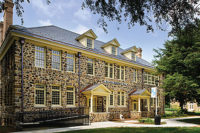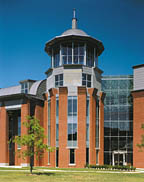
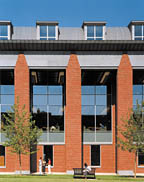
"We knew Bluestone would be comparable to limestone in its texture," said Joseph Tattoni, principal architect. "In the schematic stages, the building was rendered and conceived as limestone with brick, but during the design-development stage, we decided to go with Bluestone instead of the limestone, because its texture is very similar to the other surrounding buildings made of limestone." In addition to limestone, the architects considered granite and slate before choosing Bluestone.
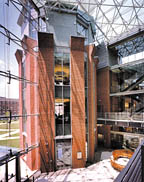
Inspired by historic beauty
The 80,000-square-foot, four-story facility, which was named in honor of retired Congressman Louis Stokes, architecturally links Howard University?s past and future."The overall design goal was to incorporate the language of this historic campus in a modern twenty-first century health sciences library; in trying to achieve that goal, we explored the forms and materiality of the campus, which has a very rich tradition of brick and limestone," said Tattoni.
Howard University was established in 1866, as a theological seminary to train African-American ministers to spiritually aid over four million freed slaves. It was named after Civil War hero and founder of Freedman?s Bureau, General Oliver Otis Howard. Many displaced African-Americans populated Washington D.C. during the late 1800s. To care for their medical needs, the Freedman Bureau founded Freedman?s Hospital in 1867, which became a teaching hospital for the Howard University medical school.
Freedman?s Square, which was the large green space that separated the hospital and medical school, was turned into a parking lot in 1954. This is the area where the Louis Stokes Health Sciences Library was recently built.
In designing the building, Hillier architects chose exterior materials and architectural forms that recall the university?s main campus, which was designed in the 1930?s by Albert Cassell. "We reinterpreted the historic look in ways that accommodate the needs of a technologically advanced facility while linking the old campus to these twenty-first century additions," said Tattoni.
The selection process for choosing the right type of Bluestone for the project was not too difficult. According to the architect, many different types of the material would have worked well for the project. The final choice was narrowed down from three specific types of Bluestone -- Elk Brooke, Endless Mountain or Pietra Serena Bluestone.
"We got samples and compared them," said Tattoni. "We decided they were all in acceptable range." The contractor made the final decision in specifying the particular type of Bluestone that would be installed. The Elk Brooke Bluestone, which was supplied by Vickery Stone Co. of Havertown, PA, and fabricated by Johnston & Rhodes of East Branch, NY, was selected. According to installer Manuel Seara, the Elk Brooke Bluestone was chosen for it beauty and durability. "It is a beautiful material, is domestic, and looks unique," he said. It has more character than a lot of other stones, and it holds well over time."
The stone served primarily as trim elements and accent features, as limestone is similarly used on neighboring buildings. The Bluetone was employed on the interior windowsills, rotunda, the arches above the colonnade, and was used as a support for the 90-foot glass cupola at the entrance of the building. It was also applied at the base of the library?s main reading room and the lobby?s interior. Overall, more stone was used on the building?s exterior than interior.
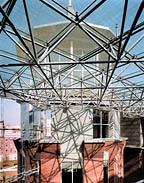
The installation process
The Bluestone was specified in a variety of shapes and sizes, withthe largest piece employed at the colonnade arch. The typical pieces used for the project ranged from 6 to 8 feet, although some larger pieces were up to 12 feet long, and weighed about 10,000 pounds per piece.
All the stone pieces were installed with the assistance of a crane, and the joints were caulked and supported by stainless steel anchors. According to Seara, nothing could be handset on either the exterior or interior, because the pieces were too heavy. "The interior is really a continuation of exterior work," explained the installer. It took a small crew of no more than six workers, which took two months to complete.
According to the installer, the major difficulty was installing the larger pieces of stone with the roof already installed. "The stone was installed after the roof framing had been installed, and in order for us to lift the stone in place, we had to make a hole in the roof and drop a cable to lift the stone in place," said Seara. "We had to rig a cable through the roof and double pick the stone in two phases." Aside from these difficulties, the installation for this project was fairly typical.
CREDIT BOX:
Louis Stokes HealthSciences Library
Washington, DC
Architect: Hillier, Princeton, NJ, in a joint venture with the Amos, Bailey and Arnold Ltd., Baltimore, MD
Stone Installer & Supplier: Lorton Contracting Co., Inc., Lorton, VA
General Contractor: Amec Co.
